 |
 |
 |
 |
 |
 |
 |
 |
 |
 |
 |
 |
 |
 |
 |
 |
 |
 |
 |
 |
 |
 |
 |
 |
 |
 |
 |
 |
 |
 |
 |
 |
 |
|
|
|
|
|
|
|
|
|
|
|
|
|
|
|
|
|
|
|
|
|
|
|
|
|
|
|
|
|
|
|
|
|
|
|
|
|
|
|
|
|
|
|
|
|
|
|
Built along exactly similar lines to the company's smaller "D.B.C.175" lathe with the bed and its supporting plinths cast as one piece the DIMCO "D.G.M. 225" was, at 8-inch centre height and 59 or 79-inches between centres, a reasonably if not massively lager and more powerful machine. The close-grain, cast-iron V-way bed was 143/16-inches wide with the trade-mark DIMCO lattice-like cross bracing between the front and back walls. A 10-inch long removable gap was provided as standard and, when lifted out, enabled a piece of metal up to 27¼ inches in diameter and 6-inches deep to be turned on the faceplate.
Inside the headstock-end plinth was a 10 h.p or (optionally) 7 h.p. 2-speed motor driving, through 5 V-belts, a 4-speed-gearbox with its output directed through 5 more V-belts and multi-disc clutches. Mounting a self-contained box in this position, with drive to the headstock by belts, was intended to reduce vibrations associated with meshing gears from being transmitted to the workpiece and was usually a design employed on better-quality toolroom lathes - its use in a more modestly-priced lathe was unusual, though not unique. The casing of the cast-iron gearbox was split vertically and contained three alloy-steel tempered and ground shafts running in ball races and carrying hardened and ground gears; the base of the box provided an oil sump from which lubricant was drawn through a metallic-mesh filter and then pumped through a pipe to the headstock where it lubricated the headstock spindle bearings and gears. From there it drained down to the screwcutting gearbox first oiling the screwcutting gears and then, by collecting in a trough at the bottom and half submerging them, the power-feed drive gears. The overflow oil drained back to the speed-change gearbox passing through the gears before finally settling into the sump where the multi-disc clutches were located.
The headstock was of box form, in grey cast iron and internally ribbed for greater rigidity. It carried a case hardened, tempered and ground spindle with a "200 AM STD". internal taper and on its nose an American long-taper in an L1 size.
Continued below:
|
|
|
|
|
|
|
|
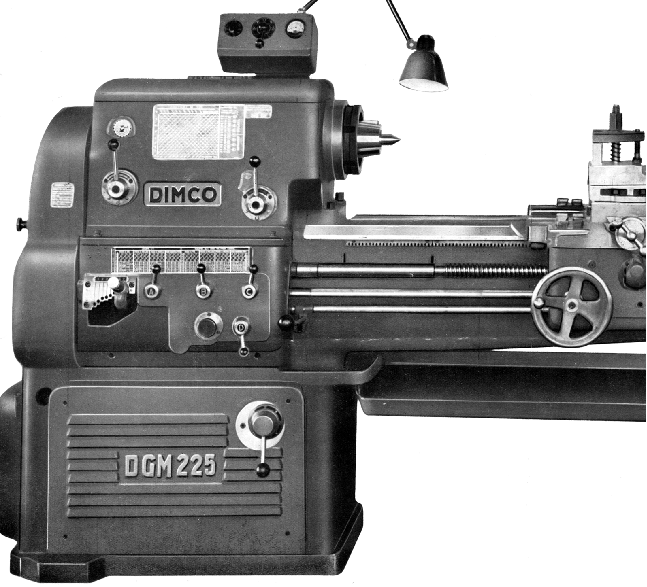 |
|
|
|
|
|
|
D.G.M. 225 8-inch centre height by 59 or 79-inches between
|
|
|
|
|
|
|
|
|
|
|
|
Continued:
Built into the front section of the headstock was a splash-lubricated, hardened and ground backgear assembly that doubled the speed range of the cabinet mounted gearbox and gave (in conjunction with the 2-speed motor) 16 usefully-spaced speeds from 34 to 1700 rpm or, optionally, 19 to 1000 rpm.
Apart from an opening in the front to allow the use of a sliding tumbler selector the screwcutting and feeds gearbox was completely enclosed. All shafts were made from case-hardened steel and ground and the special alloy-steel gears heat treated. Changes of pitch and rates of power feed were, as with the smaller DIMCO lathes, made separately with the former altered by the juxtaposition of 4 levers in combination with the sliding selector and the latter by a rotary knob with 5 settings available without altering the gear train. The leadscrew was used only for screwcutting and the power feeds transmitted to the apron through a separate shaft protected by "ball-and-spring" overload clutch. The sliding rate ranging from 0.002" to 0.04" and the surfacing feeds from 0.0006" to 0.013" Both feeds (but not screwcutting pitches) could be instantly changed without any need to stop the lathe. The gearbox was able to generate 34 metric threads from 0.25 to 28 mm pitch, 63 inch threads from 112 to ¾ t.p.i. (including 11.5 t.p.i.) 32 Modulus threads from Mod 0.125 to 14 and 28 Diametric threads from 224 to 2 pitch.
The apron was a model of mechanical simplicity with the leadscrew clasped by twin nuts and the keyed power shaft passing through and driving a bevel gear that transmitted its motion to a set of spur gears. A single lever control on the face of the apron both selected and engaged the feeds and, because the mechanism did not become loaded under heavy cuts, it was possible to flick the drive in and out as required. Although the apron was not doubled-walled and hence lacked the luxury of oil-bath lubrication troughs cast into the top face of the unit provided wick feeders with a supply to direct the various shafts below. Pivoting on the right-hand face of the apron and hinged just outboard from the screwcutting gearbox, were conveniently positioned levers connected to a "third-rod" control by which means the spindle could be started, stop or reversed.
Unlike the "Model D.B.C. 175", whose bed ways stopped beneath the spindle nose, those of the "225" continued a little way beneath the front bearing and so allowed the carriage, with its T-slotted wings, to reach closer to the spindle. The result was that the cross slide, instead of having to be being set off-centre (towards the chuck end) could be better supported by being positioned almost on the centre-line of the carriage.
Both top and cross slides were adjusted with taper gib strips, carried ball thrust bearings on their feed screws and had clearly engraved zeroing micrometer dials with narrow knurled grip rings. The handles were traditional "balanced-ball type" which, whilst handsome, might have been considered rather hard on the operator's hands on a machine of this size.
With a No. 4 Morse taper the tailstock was correctly sized to the machine but the use of a direct-bearing screw to lock its spindle was unusual for the time when nearly every other lathe of this size had a compression fittings that squeezed it
|
|
|
|
|
|
|
|
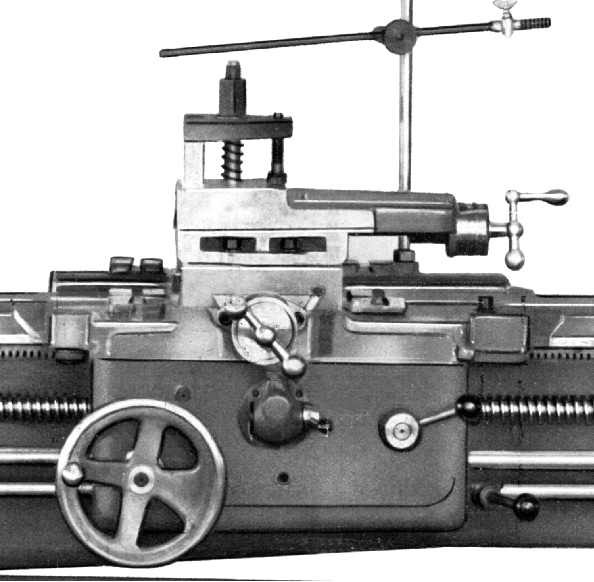 |
|
|
|
|
|
|
A model of mechanical simplicity, the apron mounted double clasp nuts to grip the leadscrew with the power shaft passing through and driving a bevel gear that transmitted its motion to a set of spur gears. The top slide was bolted down by two set screws, the cross and top slides were adjusted by tapered gib strips and the feed screws both had ball-thrust bearings. The standard toolpost was just a simple triangular clamp.
|
|
|
|
|
|
|
|
|
|
|
|
|
|
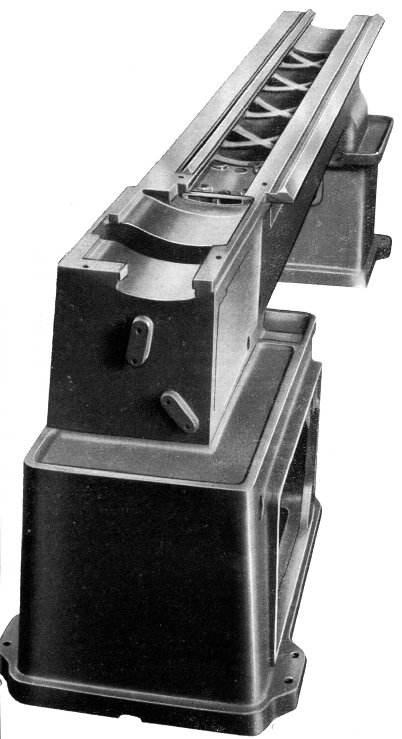 |
|
|
|
|
|
|
Built along exactly similar lines to the company's smaller "D.B.C.175" lathe the bed and its supporting plinths cast were cast as one piece.
|
|
|
|
|
|
|
|
 |
|
|
|
|
|
|
Case hardened, tempered and ground the spindle
had an American long-taper nose in a size L1
|
|
|
|
|
|
|
|
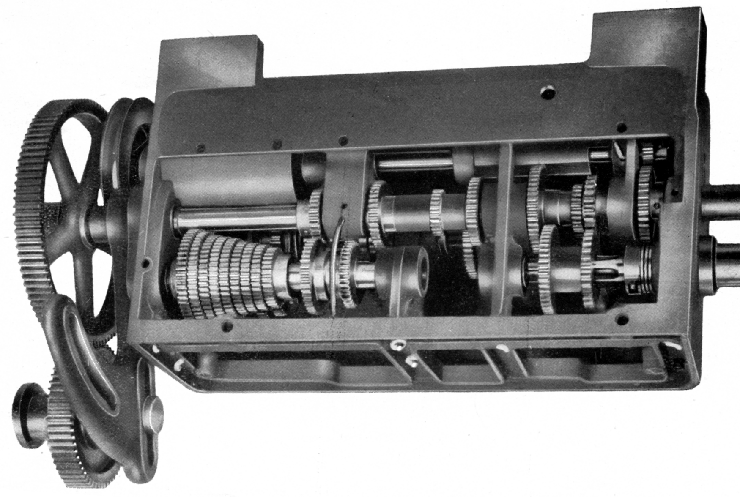 |
|
|
|
|
|
The Screwcutting and feeds gearbox provided a sliding rate ranging from 0.002" to 0.04" surfacing feeds from 0.0006" to 0.013" Both feeds (but not screwcutting pitches) could be instantly changed without any need to stop the lathe. The box was able to generate 34 metric threads from 0.25 to 28 mm pitch, 63 inch threads from 112 to ¾ t.p.i. (including 11.5 t.p.i.) 32 Modulus threads from Mod 0.125 to 14 and 28 Diametric threads from 224 to 2 pitch.
|
|
|
|
|
|
|
|
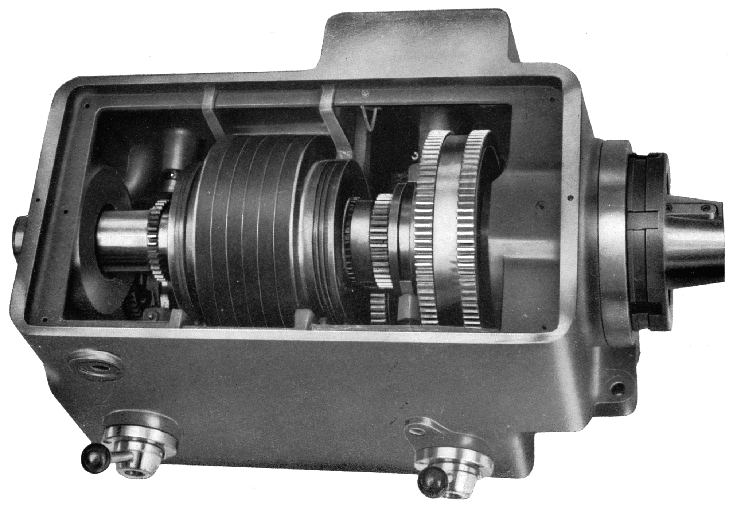 |
|
|
|
|
|
|
Of box form, the headstock was in grey cast iron and internally ribbed for greater rigidity. Built into the front section was a splash-lubricated, hardened and ground backgear assembly that doubled the speed range of the cabinet mounted gearbox and gave (in conjunction with the 2-speed motor) 16 usefully-spaced speeds from 34 to 1700 rpm or, optionally, 19 to 1000 rpm.
|
|
|
|
|
|
|
|
|
|
|
|
|
|
|
|





